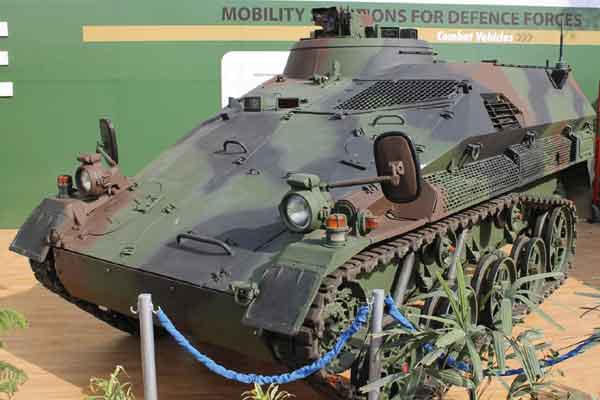The indigenous future infantry combat vehicle (FICV) for the Indian Army is in the news again with the US offering India development and production of armoured personnel carriers in a trilateral venture with Israel under the Defence Technology and Trade Initiative (DTTI).
The Army’s quest for the FICV began in 2007 with Project FICV 2017 conceived on private-public partnership basis in the defence sector. This was enabled by Defence Procurement Procedure of 2008 (DPP-2008), which lay down a “Make” procedure for developing “high-tech, complex systems” through Indian industry. The decision for such partnership was based on MoD verdict that DRDO would focus its research and development effort on projects of strategic value while Indian defence industry would be involved in high technology projects with two specific aims: one, to develop required technology base in the defence industrial sector, and; two, allowing enmeshing of design and development by single agency, in this case private industry who were to be responsible for erecting production facilities locally for their systems, assemblies, and components, in addition to providing any requisite engineering support for integration.
Foreign assistance, if required, was envisaged at systems and sub systems level through industry import that would also help further develop indigenous capabilities through technology transfer. MoD surveyed private and public industry to zero in on potential contractors.
Based on the GSQR, the Expression of Intent (EOI) worked out in 2009 laid down that the FICV will be operated by three crew members, and carry seven additional soldiers with combat loads; it must provide protection from bullets fired by 14.5mm calibre weapons; it must be amphibious, i.e. capable of floating in water; it must be air-transportable, which would imply a maximum weight of 18-20 tons; and it must have a grenade launcher, co-axial machine gun, and be capable of firing anti-tank missiles (fire and forget type).
MoD is to fund 80% of the cost of developing the FICV; the selected contractor is to pay 20%. It has been mandated that the FICV must have an indigenous content of at least 50%. The EoI was sent to Mahindra Defence Systems, Tata’s, L&T and OFB in 2009, each of whom had submitted their technical and commercial bids, while the Army continued using the Russian BMP-1 and BMP-2 vehicles that were slotted for mid-life upgrades.
However, in another decade, the Indian Army will need better and advanced vehicles to replace the upgraded BMP-2. Hence, the need to put the FICV project on fast track.
The Indian Army is looking at the production of some 3,000 FICVs to replace the upgraded BMPs at a cost of $10 billion. The project had got bogged down because Russia offered the BMP-3 but was not accepted since indigenous firms had invested heavily in the project. Finally, two developers are to be shortlisted who would be required to produce five prototypes in the laid down time frame for user trials. Attempt by OFB to partner DRDO as a design partner was not accepted under the plea that eventually DRDO will be the agency responsible for technology evaluation and approval and hence could not partner OFB.
Given the lack of design perspective actually implies that OFB will have to tie up with one of the other vendors for design and development if it wants to compete for the project but DRDO believes it will be approached for key technologies and the OFB which manufactures the BMP-II at Medak for production assistance.
As per earlier reports, this was not to be a winner-take-all competition since MoD planned to retain two production lines, the winner given 65-70% of the order; the runner-up to build 30-35% of the Army’s requirement of FICVs, provided the latter company agreed to build the winning design at the same cost as the winner. With two assembly lines operating, India’s private defence players expected that the FICV contract will create an eco-system of suppliers extending far beyond the winner of the contract.
However, above appears to have undergone change with the change of government in 2014. There has been speculation that now perhaps only one developer who tops the prototype trials will be selected to produce the FICV. This makes much more sense vis-à-vis two production lines by two separate developers, considering the issue of spares, supplies, maintenance, repairs etc. In 2014, Project FICV was planned to be restarted afresh to include indigenous firms like Bharat Forge, Punj Lloyd, Force Motors and Ashok Leyland.
These additional indigenous firms were included through a fresh “acceptance of necessity”, as approved by the MoD. The foreign firms that were likely to go in for joint ventures (JVs) with Indian partners reportedly include Rosoboronexport (Russia), General Dynamics (USA), Rafael (Israel), Nexter and Thales (France), Krauss-MaffeiWegmann (Germany) and Doosan Group of Republic of Korea. After approval of the ‘acceptance of necessity’ and inclusion of more domestic companies, detailed reports were to be submitted to MoD by end 2014. The two development partners were then to be shortlisted to build the prototypes.
However, all this appears to have got log-jammed due to remains stuck in bureaucratic bottlenecks and wrangling, corporate rivalry and controversies. As mentioned above, the US too has offered trilateral collaboration of US-India-Israel JV for producing the FICV under the DTTI.
It was reported in June 2017 that the FICV project for the Indian Army is likely to be taken up by the Defence Procurement Board (DPB) headed by the Defence Secretary. Media quoted a source in saying, “As per the procedure, once the DPB addresses some issues related to the FICV project raised by certain companies earlier this year, it will go to the DAC.” Apparently many issues, even if they be procedural in nature, are hampering progress in this project. There also seems to be no clarity over the number of development agencies the MoD would need to have for this program.
The process needs to be speeded up after the strategic partnership (SP) model was approved by the Cabinet Committee on Security, albeit grey areas still remain. It appears that OFB plus two indigenous part companies may eventually be selected to design and build the prototypes. Hopefully, Defence Minister Nirmala Sitharaman pushing meetings of the Defence Acquisition Council to fortnightly basis will give the much delayed FICV project the required.
However, considering that the vendor / vendors selection may take another 3-4 years after the prototypes are trial evaluated, induction of the FICV will likely commence only around 2027-28, provided there are no more hurdles.






This Battle Wagon is intended to be a section transporter with the driver and the gunner being retrained “LMG section” boys. It is an excellent conception to keep it to section size rather than anything bigger as this will allow for flexibility in operations including pressing home advantages and seizing opportunities.
2300 of them should be able to transport some 20 battalions of Infantry within armoured formations for rapid strike. They would probably also be in radio contact with GPS. This should create havoc if pressed home with spear heading tanks to support advanced paratroopers in a suitable modified and updated application of the “Cold Start” doctrine.
I trust that they come suitably equipped with brooms, water sprinklers and so on in order to impress the political masters of their suitability for the Army?